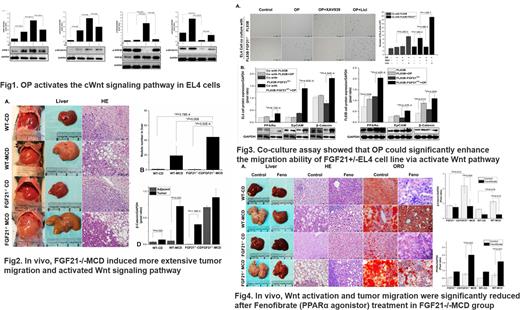Abstract
Background: Peripheral t cell lymphoma (PTCL) is an important component of NHL, the overall prognosis is worse than B Cell Lymphoma. In the hyperlipidaemic microenvironment, exploration of the relationship between de novo adipose synthesis and the proliferation and migration capacity of PTCL cells will help to discover therapeutic targets that interfere with tumor cell growth. This study attempts to explore that abnormally high levels of free fatty acids in the tumor microenvironment may promote PTCL migration and proliferation through the classical Wnt signaling pathway
Methods: The proliferation activity of EL4 cells treated with high fatty acids(OA:OP=2:1) was detected by CCK8 method, and the proportion of cells with tumor-stemness was detected by flow cytometry and Hoechst33342 stain; A C57BL FGF21-/-mouse model of non-alcoholic steatohepatitis (Nash) was constructed with the MCD method (Cholesterol & Cholate Methionine/choline deficient); PTCL tumor-bearing mice model was established by injecting EL4 cell into spleen in situ; WB method was used to detect the activation of WNT signal pathway in vitro and vivo; migration was evaluated by transwell assay.
Results:
1. In Vitro, in the OP+ EL4 group, Axin-1 and p-β-catenin were both significantly decreased (P<0.001, P=0.005), additionally treated with XAV939 (WNT inhibitor) or LiCl (WNT agonistor), Axin-1 and p-β-catenin both showed a significant increase (P<0.001, P=0.002) or degradation of GSK3 β/p-β-catenin (P=0.033, P<0.001). Suggesting that OP could activate the Wnt pathway in EL4 cells.
2. In Vivo, compared with the control group, the FGF21-/-MCD Group had the most number of nodules on the surface of the liver (FGF21-/-MCD vs WT-CD, P<0.001, vs WT-MCD, P=0.009, vs FGF21-/-CD, P<0.001), In FGF21-/-MCD Group, β-Catenin was increased in tumor tissues and adjacent tissues, especially in tumor tissues (P<0.05 in each group). Suggested that the migration enhancer in gross, and the mechanism may related with Wnt signaling pathway.
3. The co-culture assay showed that OP+El4 enhanced its migration ability, which could be decreased by Xav939 and enhanced by Licl(P<0.05 in each group). 4. in Vivo, After treatment with PPARA agonist, β-catenin EPCAM decreased in all MCD groups (P<0.05). It is suggested that fenofibrate can improve the tumor outcome by correcting abnormal lipid metabolism and weakening the activation of Wnt pathway.
Conclusion: High free fatty acids are associated with a poor prognosis in PTCL. Possibly mechanism is the activation of the canonical Wnt pathway by free fatty acids, which promote enhanced tumor cell proliferation and migration capacity. Effective Hypolipidemic therapy may be a new combined therapeutic target for PTCL patients with hyperlipidemia.
Disclosures
No relevant conflicts of interest to declare.
Author notes
Asterisk with author names denotes non-ASH members.


This feature is available to Subscribers Only
Sign In or Create an Account Close Modal